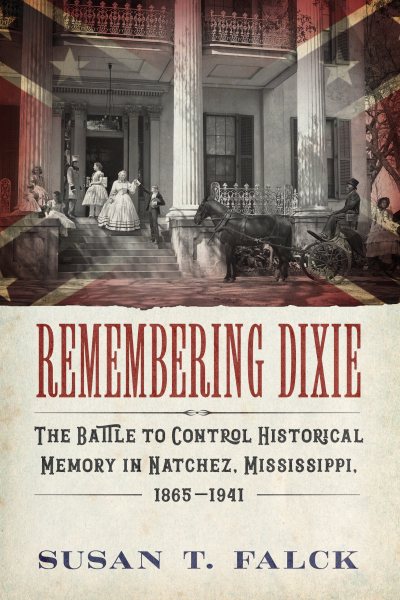By Jay Wiener. Special to the Clarion-Ledger Sunday print edition (September 1)
 Reverberations remain from decades during which Southerners acted as if the Civil War was not concluded with the Confederacy losing. The narrative evolved through variations on a theme, but constant was diversion from discussion of a multiracial society.
Reverberations remain from decades during which Southerners acted as if the Civil War was not concluded with the Confederacy losing. The narrative evolved through variations on a theme, but constant was diversion from discussion of a multiracial society.
Remembering Dixie: The Battle to Control Historical Memory in Natchez, Mississippi 1865-1941 offers opportunity to rethink the narrative. Author Susan T. Falck writes, “In crafting their historical consciousness whites emphasized the gentility of southern civilization, the valor of Confederate soldiers, and the courage of female and elderly male civilians who heroically protected the home front. The memory… was selective, with little room for black experiences told from a black perspective.”
Experiences during enslavement of people of color of mixed blood and in the free black community, and hierarchies arising through differences, were overlooked by “… white Civil War memoirists who subscribed to the notion that the South was tragically victimized during the war and Reconstruction.” Fixation upon the Lost Cause crippled the South—and the country—because it begat orthodoxy as rigid as Stalinism, stopping expansive inquiries:
What other possibilities exist?
What options offer optimal outcome?
Why ignore them?
One-dimensional defense of the slavocracy—as a paradise lost—prohibited white Southerners from full appreciation of how emancipation felt for former slaves, the experience during Redemption, at which time freedoms were revoked, and the dehumanization which ensued. Remembering Dixie yields insights.
Chapter Four addresses lacunae through discussion of photography in Natchez. That examination alone justifies buying the book, in the manner that one purchases magazines without reading everything. Art History classes are likely to utilize it. Anyone interested in photography ought to consider it, given profound perspective into the “thousand words” that a picture is supposedly worth.
The author writes, “[Henry] Norman’s photographs empowered his black subjects to directly challenge the rampage of racist cartoons, jokes, articles, and pictures circulating in the pages of newspapers and consumer periodicals nationwide. As symbols of personal and collective empowerment, Norman’s portraits contested characterizations of blacks as innately inferior, simplistic, and unworthy of respect or civil rights.”
Chapter Five is no less essential. “The creators of the Pilgrimage repackaged the dramatization of a mix of decades-old southern racialized ideology and white historical memory initiated in the early postbellum period as a product for Depression-era consumption.” Slavocracy was sold as an idyll, superior to the dislocations of the Great Depression and industrialization. “Out of the more practical features of the North we may have obtained our economic status, but it is to the South that we turn for the music and romance of our yesteryears.”
Otherwise put, “… the Pilgrimage invited 1930s audiences to step inside the world of Scarlett O’Hara and Rhett Butler and experience vicariously a carefully reconstructed mythical past.”
The advertising slogan “Come to Natchez Where the Old South Still Lives” coined by “George Healy, Jr., formerly of Natchez and an Editor of the New Orleans Times-Picayune…” encapsulates the anodyne delusion.
Interestingly the women spearheading the Pilgrimage exemplified anything other than Healy’s antediluvian approach: Although they inhabited traditional femininity, they were thoroughly modern, shrewd and calculating businesswomen.
Sound business judgment ultimately created “a profound civic commitment shared by many in the community—whites and blacks—to promote and tell a more inclusive and accurate historical narrative.”
As Natchez has done so, utilizing the Historic Natchez Foundation, the Natchez Courthouse Records Project, and the National Park Service, it has instructed communities, elsewhere, struggling through challenges: “… [T]hanks to the coupling of strong and wise external and homegrown influences the healing of Natchez’s past is well underway, resulting in a flurry of innovative heritage tourism developments that while not always embracing a critically accurate narrative are more racially inclusive and historically accurate than ever before.”
Jay Wiener is a Jackson attorney.
Susan T. Falck will be at Lemuria on Wednesday, September 25, at 5:00 p.m. to sign and discuss Remembering Dixie.


Comments are closed.